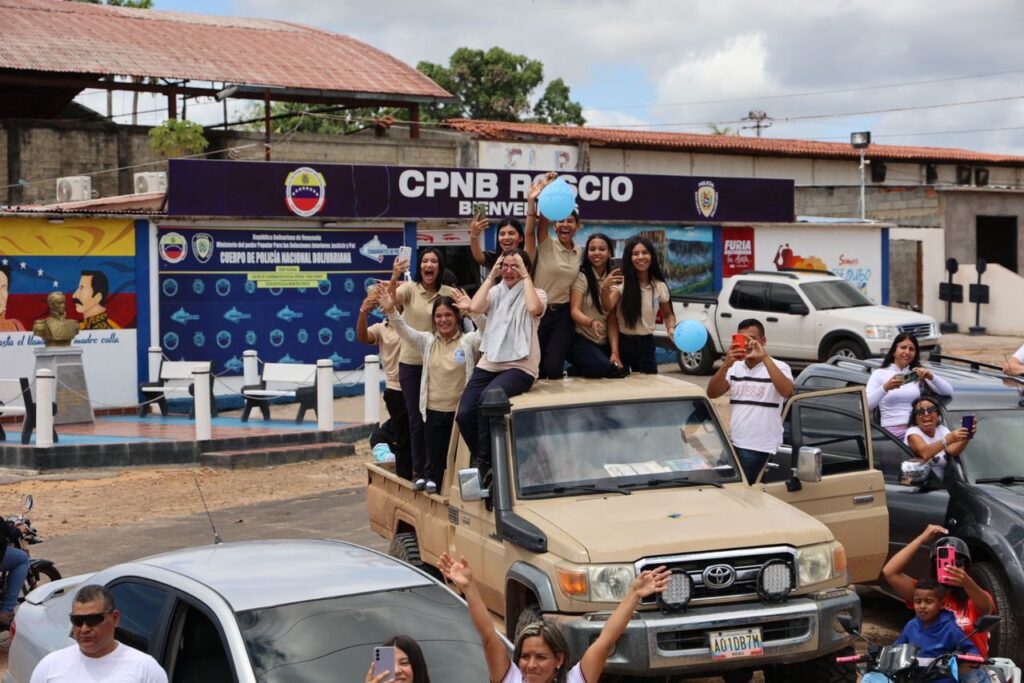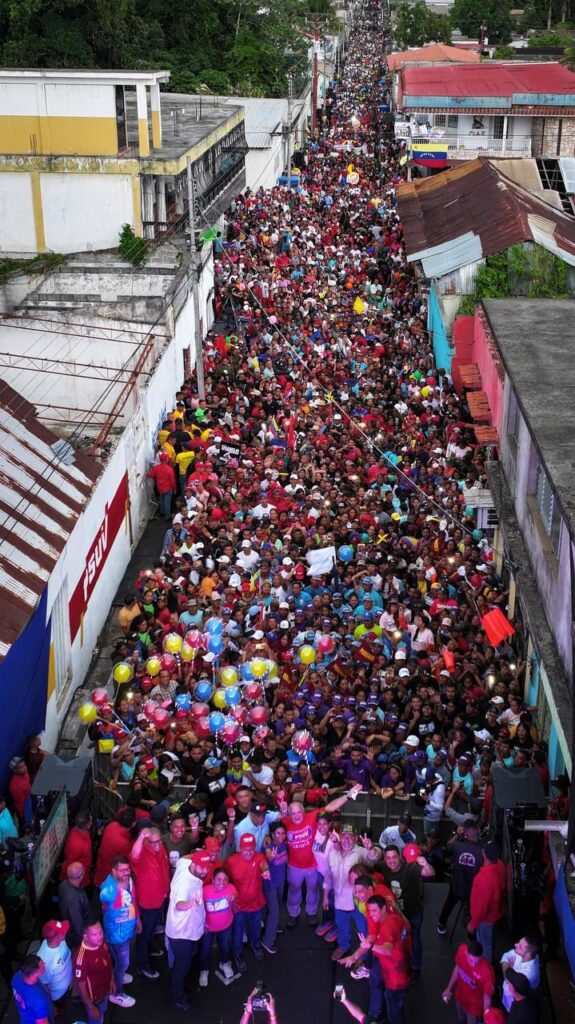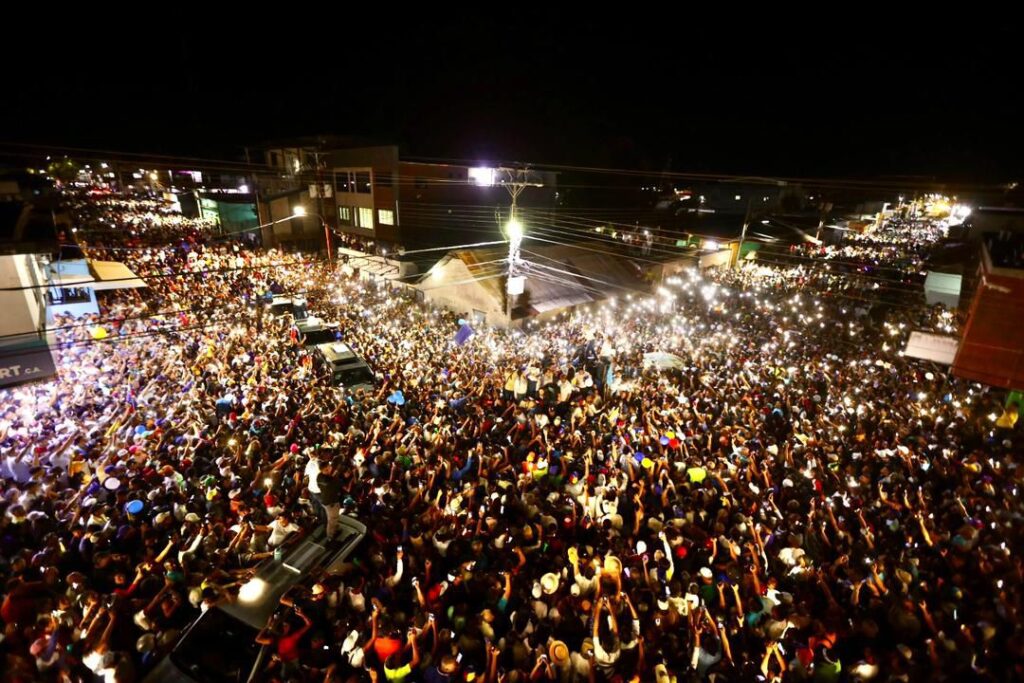Despite Gangs, María Corina Visited Venezuela’s Gold Country
María Corina Machado visited Venezuela's remote gold territory, despite the mining mafias and the Chavista grip on it. Here's how the visit went, explained by interactive geodata maps, videos and photos.


An original version of this text was published in La Patilla. The geodata maps were developed by the VE360 platform alongside Caracas Chronicles.
María Corina Machado left Puerto Ordaz after 9:00 in the morning bound for El Callao. Without knowing what she was going to find –and warned that it would not be easy and that it could even be dangerous– she decided to drive south, into the region crossed by the Orinoco Mining Arc, where mines are administered by the state Corporation Venezolana de Minería (CVM) or by criminal groups.
María Corina’s tour from San Félix to El Callao:
In San Félix, one of the two communities that make up Ciudad Guayana, Machado took Avenida Guayana to be received by her supporters at the Dalla Costa vial. From that point, she traveled through several main avenues, where many people greeted her, shouted messages of encouragement, rushed at her and even took a photo with the opposition leader.
Machado passed by the Manuel Piar Avenue, where residents of Chirica, Vista Al Sol and other parishes were waiting for her: sectors where Chavismo has won the elections in recent years. On this route, a woman on a motorcycle approached the vehicle in which Machado was riding and gave her a package of catalinas, a type of cookie that is very typical of the state.
2013 voting patterns (blue for the opposition, red for Chavismo) of areas visited by Machado
During the journey, with more and more joining more as she advanced, dozens of motorizados sought to protect Machado. She heard the story of a grandfather, who with seven children and grandchildren outside the country, confessed through tears that despite having a cardiac pacemaker wanted to approach her to tell Machado that he supported her and that she would be the winner of the electoral contest.
Leaving San Félix, Machado crossed the Palo Grande toll without problems, but the bus of the Vente youth team was stopped since that “was not the usual route of the Unity” according to the military officers.
From there, Machado proceeded to stop at each hamlet that was on Troncal 10, the main road that links the mining municipalities. In some towns there were even white and blue balloons on the facades of houses or businesses.
In all the checkpoints where she passed, Machado greeted the officials. Some responded. Others simply turned their backs. The stop in Upata was quick but there were still greetings and accompaniment. The closing ceremony of the tour in Bolívar, on June 6th, would be there.

At the heart of the Mining Arc
In Guasipati, traditional mining (and Chavista) territory, people received her with tears and smiles. Some gave their children to Machado to carry them. It was not planned to hold a rally in that municipality with one of the highest homicide rates per capita in the country, but Machado was forced to improvise one in front of the Guasipati church with a microphone from her sound truck before continuing towards El Callao. “Something is happening in Venezuela’, Agustín Acosta, a local from Guasipati, said, “people are taking off their masks, losing their fear to go out and vote.”
At El Callao, Mayor Coromoto Lugo (MUD) and a huge crowd was waiting for her, despite a Chavista rally that in the morning forced the opposition to change the location of their rally.

A calypso group, a typical musical genre of the area brought by Antillean miners in the 19th century, also accompanied the caravan. They received Machado to the rhythm of “here comes the tsunami, here comes the tsunami, hold on tight because María Corina’s tsunami is coming.” Mayor Lugo, on stage, told her that he could give her some calypso classes. “I’m the one who’s going to teach you how to dance calypso,” she replied, laughing, “You’re going to see me at the carnivals.”
El Callao there were not only the inhabitants of that town; they also came from more remote towns in the Arco Minero: from Tumeremo, from El Dorado, from Kilómetro 88.
Mines and non-state actors in areas visited by Machado
In the villages many waited for Machado to return. The bikers guided her way to Upata, where there was another crowd despite a chavista event closed three main roads that made access more difficult for the caravan. Between the slogans of “and it is going to fall, and it is going to fall, this government is going to fall” and “freedom“, night fell and Machado addressed the people of Upata. The lights of the cell phones illuminated her as she spoke, as it has become common at her nightly rallies.

She assured that just 52 days before the elections, in her last stop before leaving for the state of Delta Amacuro, the opposition was defeating the government. “We have united Venezuela,” she said, “We have united the strength and desire of those who want to live with dignity.”
Caracas Chronicles is 100% reader-supported.
We’ve been able to hang on for 22 years in one of the craziest media landscapes in the world. We’ve seen different media outlets in Venezuela (and abroad) closing shop, something we’re looking to avoid at all costs. Your collaboration goes a long way in helping us weather the storm.
Donate




